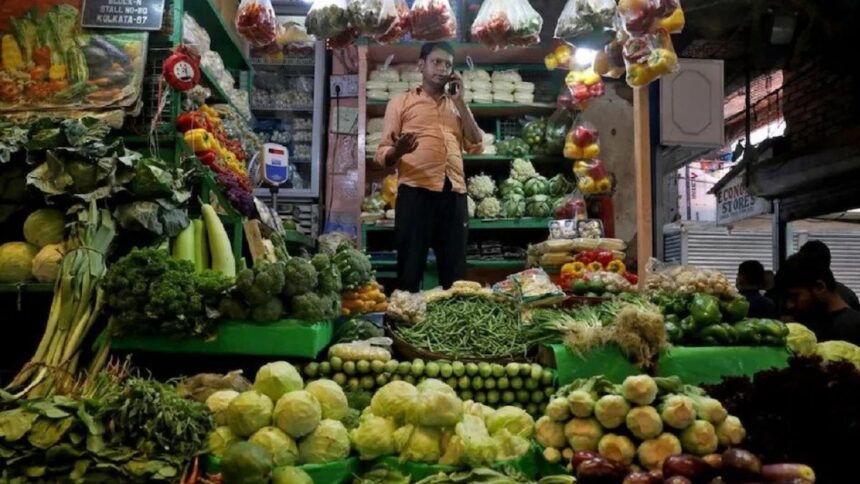India’s retail inflation in August eased to 6.83 per cent against 7.44 per cent in July as vegetable prices cooled somewhat compared to the previous month, data released by the National Statistical Office (NSO) on Tuesday showed.
At 6.83 per cent, the Consumer Price Index (CPI) inflation print for August is 61 basis points lower than July’s 15-month high of 7.44 per cent. Despite slowing down, it continued to stay outside the tolerance band of the Reserve Bank of India (RBI).
This is the fourth instance of the retail inflation rate or the consumer price index (CPI) was above the upper limit of 2 per cent-6 per cent of RBI’s medium-term inflation target in 2023 and the seventh instance since July 2022. The RBI mainly factors in retail inflation while deciding the benchmark interest rate (repo rate).
The central bank has projected the CPI inflation at 5.4 per cent for 2023-24.
On the other hand, India’s industrial output grew by 5.7 per cent in July from 3.8 per cent in June. The July IIP growth of 5.7 per cent is above expectations of 5.0 per cent.
India’s urban CPI slowed to 6.59 per cent from 7.20 per cent in July, while rural inflation fell to 7.02 per cent from 7.63 per cent a month ago.
Food inflation, which accounts for nearly half of the overall consumer price basket, rose to 9.94 per cent compared with 2.91 per cent in the previous month.
Vegetable prices, still high, rose 26.1 per cent against a staggering 37.34 per cent rise in July, while prices of oils and fats declined by 15.3 per cent after dropping by 16.8 per cent in the previous month.
Cereal prices remained in double digits and rose 11.6 per cent in August as compared with 13 per cent in July. Milk and milk products inflation came in at 7.7 per cent as compared to a rise of 8.34% in the previous month.
The price data were collected from selected 1,114 urban Markets and 1,181 villages covering all states/UTs through personal visits by field staff of the Field Operations Division of NSO, Ministry of Statistics and Programme Implementation (MoSPI) on a weekly roster.
During the month of August 2023, NSO collected prices from 99.6 per cent villages and 98.3 per cent urban markets while the market-wise prices reported therein were 88.8 per cent for rural and 91.3 per cent for urban.
In July, retail inflation, as measured by the consumer price index, surged to a 15-month high of 7.44 per cent in July this year as prices of food items, especially vegetables, shot up.
Inflation in the consumer food price index inflation rose to 11.51 per cent in July while inflation in the food and beverages basket jumped to 10.57 per cent. Retail inflation in vegetables surged to 37.34 per cent last month from a deflation of -0.93 per cent in June.
| August | July | |
| CPI urban inflation | 6.59% | 7.20% |
| CPI rural inflation | 7.02% | 7.63% |
| CPI core inflation | 4.8% | 4.9% |
“August CPI inflation at 6.83 per cent was in line with our expectations of 6.86 per cent. Vegetable prices moderated and led much of the moderation in the August print. However, cereals and pulses continued to see upside and we need to be cautious of this trend being more sticky. Core inflation at 4.9 per cent was similar to July print though tad higher than our expectation. CPI inflation should moderate further to around 5.5 per cent by December if the current trend of food prices persists. We continue to expect the RBI to remain cautious as inflation remains well above the 6 per cent mark. We maintain our call for an extended pause as the RBI watches for the domestic growth-inflation mix, food prices trend and impact on inflation expectations, and impact of global monetary policy decisions on the INR,” said Suvodeep Rakshit, Senior Economist, Kotak Institutional Equities.
“Offering a modicum of relief, the CPI inflation eased below the 7 per cent mark in August 2023 to a lower-than-expected 6.8 per cent, largely led by vegetables, amidst some moderation in the prints for clothing and footwear, housing and miscellaneous items as well. While we expect the CPI inflation to print in the range of 5.3-5.5 per cent in September 2023, this will still entail an average of 6.6 per cent for Q2 FY2024, well above the MPC’s August 2023 forecast for this quarter. We expect the MPC to remain on hold in October 2023, while continuing to demonstrate caution amid a cloudy outlook for food inflation and elevated crude oil prices,” said Aditi Nayar, Chief Economist, Head, Research & Outreach, ICRA Ltd.
“The headline CPI inflation came to 6.83% YoY against an expectation of 7.10%. The fall can be largely attributed to a steeper fall in food inflation led by the fall in vegetable inflation. Core inflation has come at 4.9%, in line with expectations. While this number is somewhat a relief, the average run rate still continues to remain above RBI estimates. Elevated cereal inflation, along with uncertainty around monsoons, will keep RBI on guard and hence we expect caution to continue from RBI’s end. Bond markets might take a bit of relief and see a slight downward movement in yields in the near term, the persistence of inflation and trajectory will determine the larger move. So we expect yields to remain range-bound and take a slight breather from the slow hardening that we have seen in recent times. We expect 10-yr benchmark G-Sec to trade in the range of 7.10%-7.25% in the near term,” said Akhil Mittal, Senior Fund Manager-Fixed Income, Tata Asset Management.
July’s IIP
The index of industrial production (IIP) growth for July came at 5.7 per cent. At 5.7 per cent, the latest industrial growth figure as per the Index of Industrial Production (IIP) is at a five-month high.
For the month of July 2023, the Quick Estimates of Index of Industrial Production (IIP) with base 2011-12 stood at 142.0. The Indices of Industrial Production for the Mining, Manufacturing and Electricity sectors for the month of July 2023 stand at 111.9, 141.2 and 204.0, respectively. These Quick Estimates will undergo revision in subsequent releases as per the revision policy of IIP.
As per use-based classification, the indices stand at 141.7 for Primary Goods, 101.6 for capital goods, 151.8 for Intermediate goods and 168.5 for infrastructure/ construction goods for July 2023.
Further, the indices for Consumer durables and Consumer non-durables stand at 118.1 and 152.2 respectively for the month of July 2023.
Industrial growth had come in at 3.7 per cent in June, which was later revised to 3.8 per cent – and was 2.2 per cent in July 2022.
For the first four months this fiscal, India’s industrial output is up 4.8 per cent year-on-year, down from 10.0 per cent in April-July 2022.
“The IIP print for July 2023, at 5.7 per cent, exceeded our expectations, on account of a better-than-expected performance of the manufacturing sector. The YoY performance of most available high frequency indicators improved in August 2023 relative to July 2023, including freight and electricity generation. Based on these trends as well as a favourable base (-0.7 per cent in August 2022), ICRA expects the YoY IIP growth to witness an uptick to ~5-7 per cent in August 2023,” Nayar of ICRA Ltd said.
Also read: EPFO, NPS data show India created 5.2 crore payrolls in last 4 years: SBI Ecowrap
Also read: ‘No such proposal’: Nitin Gadkari dismisses reports of 10% additional tax on diesel-engine vehicles








